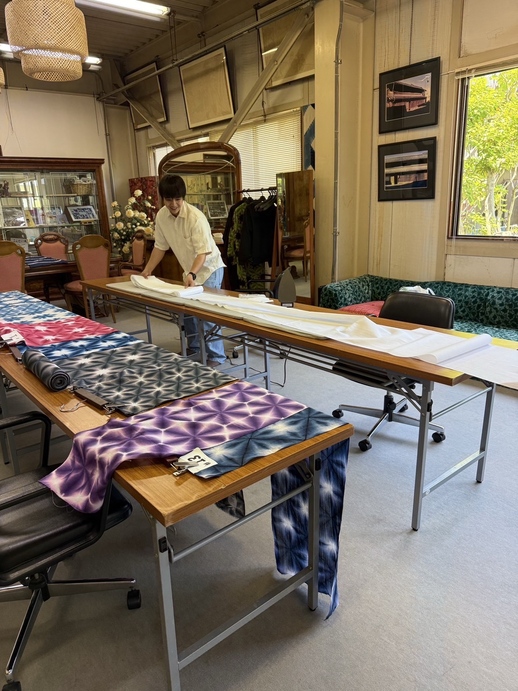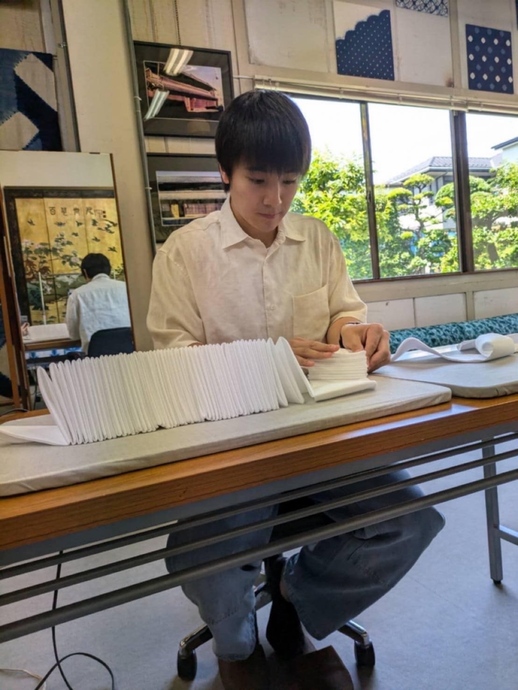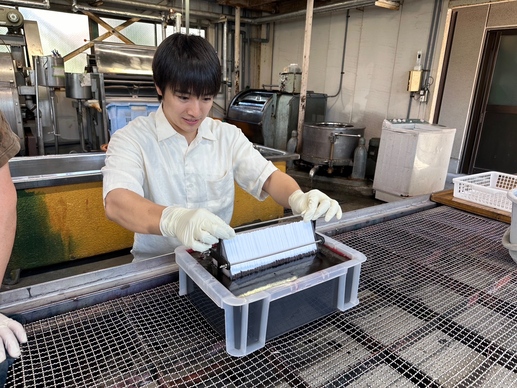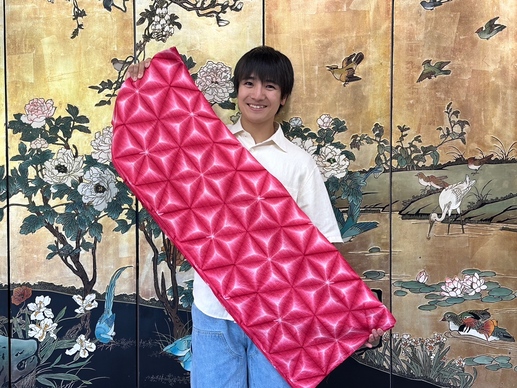2025.07.10
コラム/エッセイ「本田剛文の伝統!堪能!感動!」 第1回 有松・鳴海絞
本田剛文=BOYS AND MEN(ボイメン)メンバー
東海地区を中心に活動する、BOYS AND MEN(ボーイズ・アンド・メン、略称ボイメン)のメンバー、本田剛文です。芸能活動の傍ら、さまざまな伝統文化に触れ、楽しんでいます。これから自分の体験を基に、伝統文化の話題や魅力をお届けします。
生粋の愛知県民である僕にとって、絞り染めといえば「有松・鳴海絞」が真っ先に浮かびます。その歴史は実に400年以上。脈々と受け継がれ、そして発展してきた地域の宝ともいうべき存在で、国の伝統的工芸品にも指定されています。驚くべきは豊富な絞り技法のバリエーション。長い歴史の中でなんと100種類以上も生み出されてきたのだそう。三浦絞り、鹿子絞り、竜巻絞りなど、独特の美しさと肌触りを生み出す個性豊かな技法の中から、今回は雪花絞りの体験をしてきました。その名の通り、雪の結晶のような模様が浮かび上がるといいます。初挑戦に、不安と期待が入り交じります。
お邪魔したのは鳴海絞の製造卸業を営み、絞り染めのワークショップも開催している名古屋市の「有限会社こんせい」。まずは、浴衣生地の反物を三角形に折りたたむ作業からスタートです。

まずは反物をセッティング
アイロンを使いながら力強く、丁寧に、山折りと谷折りを繰り返して蛇腹状にします。ただ折るだけの単純作業と侮るなかれ、約13メートルにも及ぶ反物の途方もない長さを前にして、折れども折れどもゴールが一向に見えてきません。集中力を切らさぬように自分を律しながら、とにかくきれいな三角形を目指します。この作業を丁寧に行うほど、均整の取れた模様になるとのことなので気が抜けません。折りたたみ続けること2時間弱。ようやく完了です。しかし、思いがけずゆがんでいる部分も多々あり、単純なようで難しい作業なのだと痛感しました。次はもっときれいに折りたたむぞ、などと早くも再訪のことを考えてしまう自分のモチベーションの高さにもビックリ。

三角形への折り作業
次はいよいよ染めの工程。折りたたんだ反物を板で挟んで染料に浸します。悩ましいのは、浸す向きや深さなどで模様の出方が変わるということで、どのような“雪の花”が咲くのか、命運はここでの選択次第。そんな一期一会の感じもたまらなく楽しいと感じつつ、じっくりと悩みます。熟考の末に「三角形の底辺から深めに浸す」ことを決断してトライ。早すぎず遅すぎず、生地に染料が浸透するスピードに合わせながら浸します。今回は職人さんがガイドをしてくださったおかげでちょうど良い具合にできましたが、実際にはかなりさじ加減が難しく、テクニックを要する工程であるということがよく分かりました。

染め工程へ
浸した状態で数分間静止し、しっかり染料を染み込ませたら、水洗いや脱水などの工程を経てついに完成! 思った以上にきれいに仕上がったと自分なりには大満足です。素人ならでは粗さも随所に見えるものの、それも味であり、自分だけの一品であるという喜びポイントです。この反物で浴衣を仕立て、夏になったら自慢げに着るところまで想定しているので、今からワクワクが止まりません。

完成!
一方で、実際に体験したおかげで職人さんのすごさを再確認することもできました。雪花絞り一つとっても、折り方・染め方にはまだまだ種類があるとのことですし、緻密かつ複雑な技法は他にもたくさん存在します。一つ一つが非常に奥深く、会得に大きな努力を要するものであろうことは、今回の体験を通じてハッキリと想像できました。それら素晴らしい技を受け継ぎ、守り、そして腕を振るってくださることに感謝と尊敬の念でいっぱいです。これからも末永く有松・鳴海絞が輝き続けるよう願いながら、絞り染めの品物をこれまで以上に積極的に手に取っていきたいと思います。
【English version】
Traditions! Enjoyed! Impressive!" The 1st Arimatsu/Narumi shibori
Takafumi Honda = BOYS AND MEN (BOYMEN) member

Completed Narumi shibori (courtesy of the author)
I am Takafumi Honda, a member of BOYS AND MEN (Boyz and Men, abbreviated as Boimen), active mainly in the Tokai area. Aside from performing arts, I enjoy experiencing various traditional cultures. From now on, I will bring you topics and attractions of traditional culture based on my own experiences.
As a genuine resident of Aichi Prefecture, the first thing that comes to mind when I think of tie-dyeing is "Arimatsu-Narumi shibori. The history of this dyeing technique goes back more than 400 years. It has been handed down from generation to generation and has developed into a regional treasure, and is designated as a national traditional craft. What is surprising is the abundant variation of tie-dyeing techniques. In its long history, more than 100 different types of shibori have been produced. Among the many unique techniques such as Miura shibori, Kako shibori, and Tatsumaki shibori that produce unique beauty and texture, I had a chance to experience snowflake shibori. As the name suggests, it produces a pattern that looks like snow crystals. I was both anxious and excited to try it for the first time.
We visited Konsei Co., Ltd. in Nagoya City, which is a manufacturer and wholesaler of Narumi shibori and also holds tie-dyeing workshops. We started by folding yukata fabric into triangles.

First, set up the fabric.
Using an iron, they fold the yukata fabric into a bellows shape, carefully and forcefully, repeating the mountain folds and valley folds. Do not be fooled into thinking that it is a simple task to simply fold the fabric, as the tremendous length of the fabric (about 13 meters long) makes it difficult to reach the goal. The more we fold and fold, the more we are forced to keep our concentration, and to keep the triangles neat and clean. The more carefully I do this work, the more even the pattern becomes, so I cannot let up. After less than two hours of continuous folding, the folding process is finally complete. Finally, it is done. However, there were many parts that were unexpectedly distorted, and we realized that this work, though simple, is very difficult. I was surprised at how motivated I was to fold it more neatly the next time, and I was already thinking about revisiting the process again.

Folding into triangles
The next step was the dyeing process. The folded fabric is placed between boards and dipped in dye. What is troubling is that the direction and depth of the soaking process affect the appearance of the pattern, and the fate of the “snowflakes” depends on the choices made here. I was enjoying this once-in-a-lifetime experience, and I was also having a hard time deciding which “snowflake” would bloom. After much deliberation, I decided to soak the dough deeply, starting from the bottom of the triangle. Soaking is done neither too fast nor too slow, and is done in accordance with the speed at which the dye permeates the fabric. This time, the craftsman guided me and I was able to get it just right, but in reality, it is a very difficult process that requires a great deal of skill and technique.

To dyeing process
After soaking the fabric for a few minutes to allow the dye to soak in, the fabric was finally finished after washing and dehydration! I was very satisfied with the finished product, which was more beautiful than I had expected. Although there are some roughnesses that are typical of amateurs, I am happy to say that they are also a part of the taste and that it is my own unique product. I am now so excited that I am planning to make a yukata (summer kimono) out of it and wear it proudly in the summer.
On the other hand, the hands-on experience also allowed me to reconfirm the amazingness of the craftspeople. Even for a single snowflake shibori, there are many more types of folding and dyeing methods, and there are many other elaborate and complex techniques. I could clearly imagine through this experience that each of these techniques is very profound and requires a great deal of effort to master. I am filled with gratitude and respect for those who have inherited these wonderful techniques, protected them, and continue to exercise their skills. I hope that Arimatsu-Narumi shibori will continue to shine for many years to come, and I will be more proactive than ever in picking up tie-dyed products.
カテゴリー: コラム/エッセイ
関連タグ: #染織





